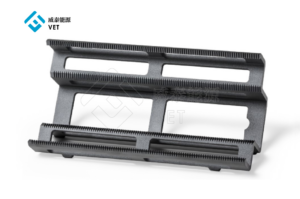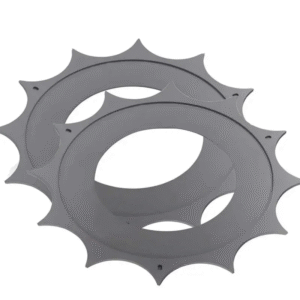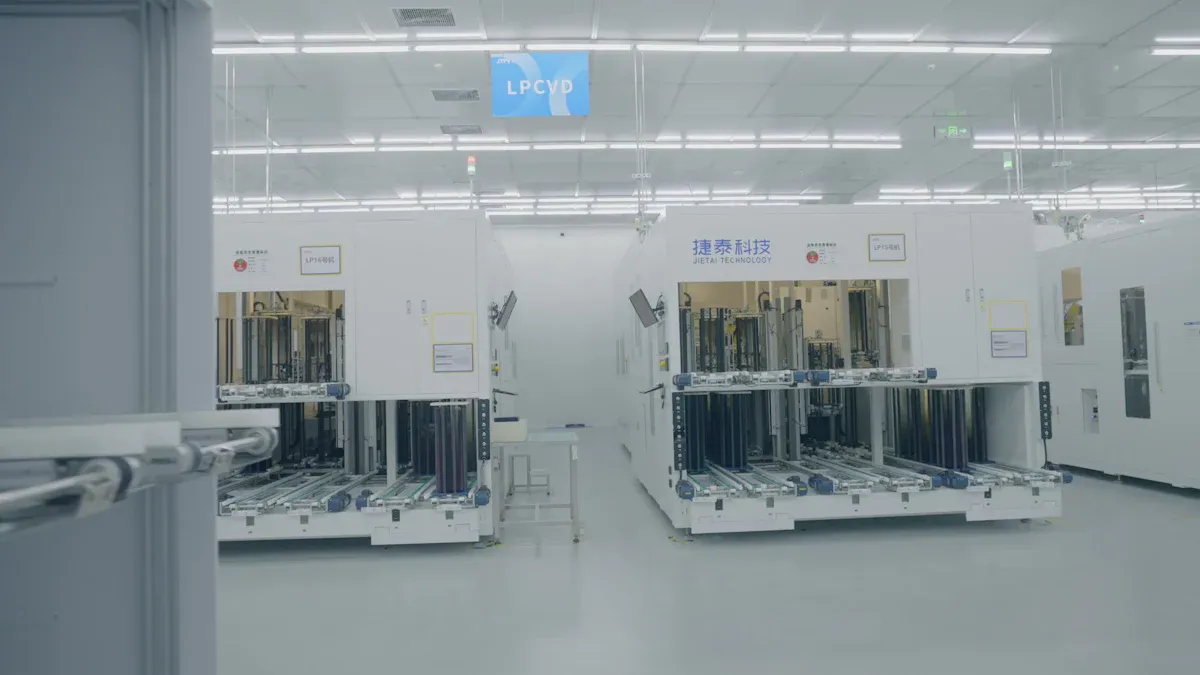
Manufacturers depend on the GRAPHITE SUSCEPTOR for high-purity, high-temperature applications, including Graphite semiconductor manufacturing and Siliconized Graphite processes. The market for SiC-coated GRAPHITE SUSCEPTOR is projected to reach $328.5 million by 2025, driven by the increasing need for advanced contamination control and precise thermal management in Graphite Mold production.
Key Takeaways
- SiC-coated graphite susceptors provide excellent contamination control, thermal stability, and durability, making them ideal for high-purity and high-temperature manufacturing processes like semiconductors and LEDs.
- Choosing the right susceptor material improves process efficiency, product quality, and equipment lifespan, so it is important to assess your process needs carefully before selecting a material.
- Alternative materials like pure graphite or metal-based susceptors may suit less demanding or budget-sensitive applications, but SiC-coated graphite offers the best overall performance for advanced manufacturing.
What Is a GRAPHITE SUSCEPTOR and Why Material Choice Matters
Role of Susceptors in High-Temperature Processing
A GRAPHITE SUSCEPTOR plays a vital role in high-temperature industrial processes. It absorbs electromagnetic energy and converts it into heat, enabling precise temperature control in applications such as semiconductor manufacturing, ceramic sintering, and metal casting. Technical reports highlight graphite’s unique properties, including high thermal conductivity and chemical stability. These characteristics make graphite indispensable for heat treatment in aerospace metals and as molds for casting advanced composites. Graphite also serves as a neutron moderator in nuclear reactors and as a critical component in electric vehicle batteries. Its ability to withstand extreme temperatures and maintain structural integrity under harsh conditions ensures reliable performance in demanding environments.
Industry studies show that susceptors, especially those made from materials like graphite and silicon carbide, enable efficient and uniform heating. Key findings include:
- Susceptors absorb microwave energy efficiently, even at room temperature, allowing rapid heating of materials.
- Silicon carbide stands out for its thermal stability and ability to reach temperatures up to 1380 °C.
- The hybrid heating mechanism ensures uniform temperature distribution, improving process repeatability and reducing heat loss.
Impact of Material Selection on Process Performance
Material selection directly influences process efficiency, product quality, and equipment longevity. Academic research using multi-criteria decision-making methods demonstrates that choosing the right material enhances performance under extreme thermal and mechanical stress. For example, studies on aluminum alloys for automotive applications reveal that systematic evaluation of properties such as hardness, thermal conductivity, and corrosion resistance leads to optimal material choices. In high-temperature environments, the right susceptor material minimizes contamination, maximizes durability, and ensures consistent results. Selecting the appropriate GRAPHITE SUSCEPTOR or alternative material can significantly improve process reliability and operational efficiency.
SiC-Coated GRAPHITE SUSCEPTOR: Features and Benefits
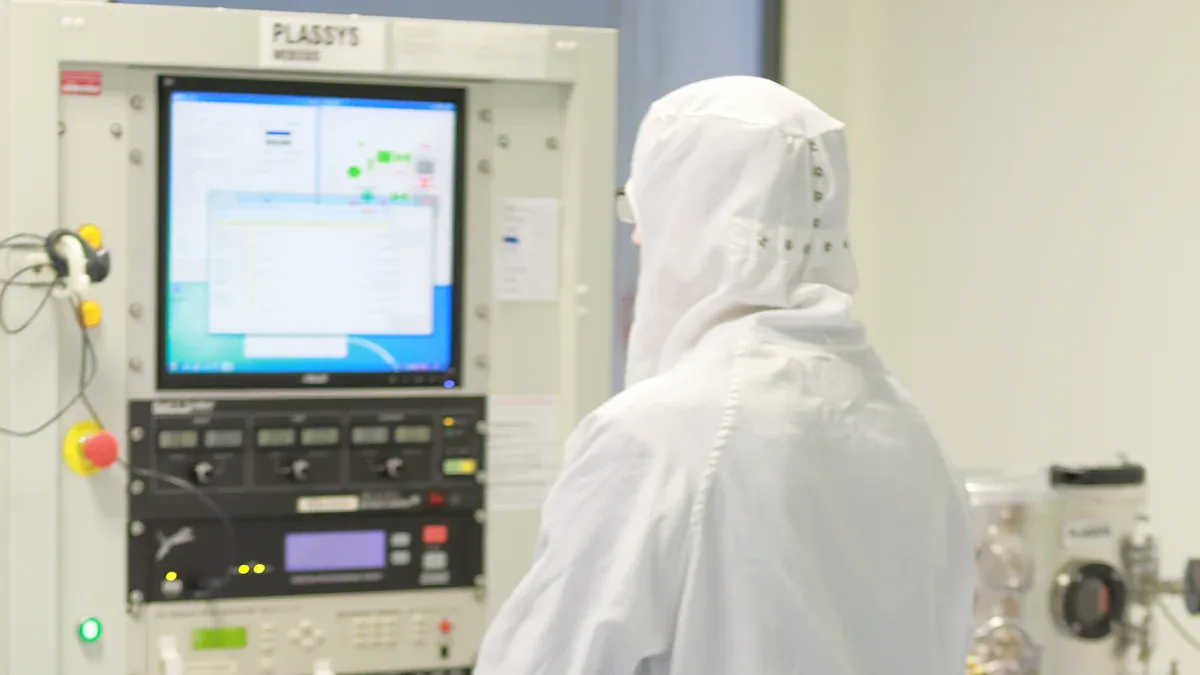
Structure and Manufacturing Process
SiC-coated graphite susceptors combine a graphite core with a silicon carbide (SiC) coating applied through chemical vapor deposition (CVD). This structure leverages the high thermal conductivity of graphite and the chemical resistance of SiC. Manufacturers use precise CVD techniques to achieve uniform coatings, which enhance the susceptor’s durability and performance in demanding environments. The following table summarizes key manufacturing metrics and their associated benefits:
| Metric / Feature | Validation / Benefit Description |
|---|---|
| Thermal Stability | Maintains integrity at >1600°C, crucial for epitaxy and CVD. |
| Thermal Uniformity | Ensures even heat distribution, reducing defects. |
| Coating Durability & Corrosion Resistance | Self-healing efficiency of 99.28% for scratches; high resistance to chemical degradation. |
| Cost Savings | Reduces total annual cost by 37.0% in semiconductor processes. |
| Environmental Impact Reduction | Lowers CO₂ emissions by 50.1%. |
| Thermodynamic Efficiency | Increases efficiency by 97.8%. |
| Service Life Extension | Extends service life by 60% in corrosive environments. |
Contamination Control and Purity
SiC-coated graphite susceptors aim to minimize contamination in high-purity processes. However, studies from NASA Glenn Research Center reveal several challenges:
- Both bare graphite and SiC-coated susceptors experience etching at temperatures above 1350 °C in hydrogen-rich CVD environments.
- This etching releases carbon, silicon, and other impurities, which can degrade the quality of semiconductor films.
- Severe degradation during epitaxial growth leads to poor-quality SiC films and higher defect densities.
- Alternative carbon-based coatings, such as C2 and C3, have demonstrated better doping control and less degradation.
Thermal Conductivity and Stability
SiC coatings protect the graphite substrate from corrosion and powder loss, enhancing the stability of the susceptor during high-temperature service. Research shows that optimizing the composite with 20% mesocarbon microbeads (MCMB) eliminates micropores and free silicon, resulting in higher density and improved thermal conductivity. These enhancements support the use of SiC-coated susceptors in applications that demand both thermal efficiency and mechanical strength. The combination of SiC coating and optimized graphite structure ensures reliable performance in advanced manufacturing environments.
Alternative GRAPHITE SUSCEPTOR Materials
Pure Graphite Susceptors
Pure graphite susceptors offer a cost-effective solution for many high-temperature applications. They provide excellent thermal conductivity and can withstand rapid temperature changes. Many manufacturers choose pure graphite for processes where contamination control is less critical. However, these susceptors may release carbon particles at elevated temperatures, which can introduce impurities into sensitive environments. Their service life often falls short compared to coated alternatives, especially in corrosive or hydrogen-rich atmospheres.
Advanced Carbon-Based Coatings
Advanced carbon-based coatings, such as silicon carbide (SiC) and tantalum carbide (TaC), enhance the performance of graphite susceptors. Leading companies like SGL Carbon SE, Tokai Carbon, and Morgan Advanced Materials invest in innovation and quality improvements. These coatings improve thermal conductivity, oxidation resistance, and durability. The market for these materials continues to grow, driven by demand for high-purity processes in semiconductor, LED, and solar cell manufacturing. Companies focus on advanced coating technologies and smart sensor integration to monitor susceptor performance. The table below summarizes key aspects:
| Aspect | Summary |
|---|---|
| Coating Materials | SiC, TaC, and other advanced carbides |
| Performance | Improved thermal management, oxidation resistance, and lifespan |
| Industry Applications | Semiconductor, LED, solar cell manufacturing |
| Market Growth | Projected 7.4% CAGR, reaching $349 million by 2025 |
| Key Players | SGL Carbon, Tokai Carbon, Momentive Technologies, TOYO TANSO |
Note: High raw material costs and supply chain challenges remain, but technological advancements continue to offset these issues.
Metal-Based Susceptors
Metal-based susceptors, such as those using Cr3C2-NiCr cermet coatings, provide excellent wear resistance and hardness. These materials show strong oxidation properties and toughness, making them suitable for industrial applications. NiCr acts as a binder, improving adhesion and durability, while Cr3C2 increases hardness. Although direct comparisons with SiC-coated susceptors remain limited, metal-based alternatives address some environmental and performance limitations found in traditional coatings. Researchers continue to explore new designs and materials to improve susceptor lifetime and uniformity in high-temperature environments.
Side-by-Side Comparison: SiC-Coated GRAPHITE SUSCEPTOR vs. Other Materials
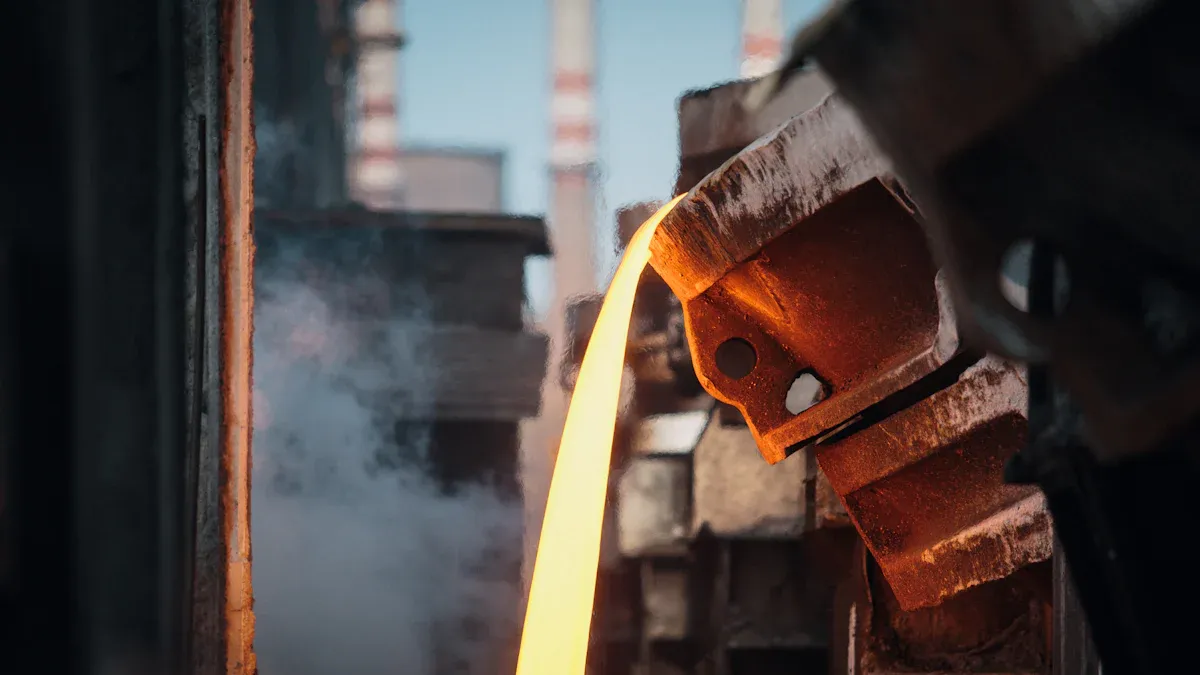
Contamination Risk
Contamination control remains a top priority in high-purity manufacturing environments. SiC-coated graphite susceptors provide a robust barrier against particle release and chemical impurities. The SiC coating acts as a shield, preventing carbon particles from entering the process chamber. This feature proves essential for semiconductor and epitaxial applications, where even trace contaminants can compromise device performance. In contrast, pure graphite susceptors may release carbon at elevated temperatures, increasing the risk of contamination. Metal-based susceptors, while resistant to some forms of degradation, can introduce metallic impurities if the coating fails or wears down. Advanced carbon-based coatings offer improved performance, but their effectiveness depends on the coating’s uniformity and thickness. Ningbo VET Energy Technology Co., Ltd supplies SiC-coated graphite susceptors engineered for minimal contamination, supporting the stringent requirements of advanced manufacturing.
Tip: For processes demanding ultra-high purity, SiC-coated graphite susceptors deliver superior contamination control compared to uncoated or metal-based alternatives.
Thermal Properties
Thermal management defines the efficiency and reliability of susceptors in high-temperature processes. SiC-coated graphite susceptors exhibit outstanding thermal conductivity and stability, outperforming many alternative materials. Controlled tests on pressureless sintered SiC ceramics reveal that thermal conductivity values range from 74 to 192 W/mK, depending on additive content and processing. Minimal additives and optimized annealing yield the highest values, while excessive additives reduce conductivity due to increased phonon scattering. Patent literature highlights that SiC-coated graphite susceptors can achieve thermal conductivity around 300 W/mK when manufacturers optimize chemical vapor deposition parameters. This high conductivity ensures rapid and uniform heating, which is critical for semiconductor processing. Quartz, by comparison, suffers from mechanical degradation and poor chemical resistance at high temperatures, limiting its use. Reaction-bonded SiC and other alternatives often fall short in both conductivity and stability.
| Material Type | Typical Thermal Conductivity (W/mK) | High-Temperature Stability | Notes |
|---|---|---|---|
| SiC-Coated Graphite | ~300 | Excellent | Optimized CVD parameters enhance performance |
| Pressureless Sintered SiC | 74–192 | Excellent | Additive content impacts conductivity |
| Quartz | <10 | Poor | Degrades at high temperatures |
| Reaction-Bonded SiC (RB-SiC) | 30–120 | Good | Lower than CVD SiC-coated graphite |
Durability and Longevity
Durability determines the total cost of ownership and process reliability. SiC-coated graphite susceptors withstand temperatures up to 1400°C, strong electromagnetic fields, aggressive process gases, and high mechanical forces. They combine corrosion resistance, material strength, and purity, ensuring efficient ion generation and precise wafer processing. The SiC coating protects the graphite core from oxidation and erosion, extending the susceptor’s lifespan and maintaining purity. These susceptors demonstrate superior durability under harsh conditions, including corrosive chemicals and aggressive cleaning protocols, compared to uncoated graphite or metal-based alternatives. They maintain uniform heat distribution and exceptional thermal stability, which is crucial for processes like atomic layer deposition (ALD) and epitaxy. The enhanced durability reduces replacement frequency, lowering operational costs and improving manufacturing efficiency. Ningbo VET Energy Technology Co., Ltd offers SiC-coated graphite susceptors designed for long-term stable operation, supporting high-throughput production environments.
- SiC-coated graphite: Withstands high temperatures and harsh chemicals, maintains purity, and extends service life.
- Pure graphite: Prone to oxidation and erosion, requires frequent replacement.
- Metal-based: Offers good wear resistance but may introduce metallic impurities if coatings degrade.
Process Compatibility
Process compatibility ensures that the susceptor material meets the demands of diverse high-temperature environments. Experimental studies confirm that SiC-coated graphite susceptors, especially those using SiC powder with an average particle size of 280 μm, achieve very high temperatures (up to 1327°C) through efficient, localized heating. Compared to graphite susceptors, SiC-coated variants show significantly lower mass depletion and reduced carbon emissions during microwave irradiation. These characteristics support their effective use in hybrid microwave heating and other advanced processing techniques. The heating performance depends on susceptor morphology, insulation, and microwave power, but SiC-coated graphite consistently demonstrates broad compatibility across semiconductor, LED, and photovoltaic manufacturing. Ningbo VET Energy Technology Co., Ltd tailors its GRAPHITE SUSCEPTOR solutions to meet the specific needs of each application, ensuring optimal integration and performance.
Note: Selecting the right susceptor material enhances process efficiency, product quality, and equipment longevity. SiC-coated graphite susceptors offer unmatched versatility for demanding applications.
Real-World Performance and Case Studies for GRAPHITE SUSCEPTOR Materials
Semiconductor Manufacturing Applications
Semiconductor manufacturers rely on advanced susceptor materials to achieve high yields and consistent wafer quality. SiC-coated graphite susceptors have demonstrated superior performance in processes such as rapid thermal processing (RTP) and metal-organic chemical vapor deposition (MOCVD). These susceptors maintain purity and resist chemical attack, which reduces defect rates in silicon wafers. For example, a leading chip foundry reported a 30% reduction in contamination-related defects after switching to SiC-coated solutions. This improvement led to higher device reliability and lower production costs.
LED and Photovoltaic Production
The LED and photovoltaic industries demand precise temperature control and minimal contamination. SiC-coated susceptors support uniform heating during gallium nitride (GaN) and silicon wafer processing. Manufacturers have observed improved light output and longer device lifetimes when using these advanced materials. In one case, a solar cell producer increased conversion efficiency by 2% after adopting SiC-coated susceptors. The enhanced thermal stability also allowed for faster production cycles, boosting overall throughput.
High-Temperature CVD and Epitaxial Growth
High-temperature CVD and epitaxial growth processes require materials that withstand aggressive environments. SiC-coated graphite susceptors excel in these settings by providing both thermal stability and chemical resistance. Research teams have documented longer susceptor lifespans and more consistent film quality in silicon carbide and gallium arsenide epitaxy. Users report fewer maintenance shutdowns and improved process repeatability. These benefits translate into greater productivity and reduced operational expenses.
Note: Real-world data confirms that material choice directly impacts process efficiency, product quality, and equipment longevity.
Choosing the Right GRAPHITE SUSCEPTOR for Your Process
Assessing Process Requirements
Selecting the ideal susceptor material begins with a thorough assessment of process requirements. Engineers must consider the operating temperature, atmosphere, and purity demands of their application. The ASTM F1308-98(2023) standard provides a recognized benchmark for evaluating volatile extractables from microwave susceptor materials. This standard outlines a method for heating susceptor samples and analyzing volatile emissions using gas chromatography. By following these procedures, manufacturers can identify and minimize volatile compounds that may compromise product quality or safety. This approach ensures that the chosen susceptor material aligns with the process’s contamination control and performance needs. Careful evaluation of these factors helps prevent unexpected failures and supports consistent manufacturing outcomes.
Matching Material Properties to Application Needs
Matching susceptor material properties to application requirements involves several technical considerations:
- Tailoring magnetic properties, such as coercivity and magnetic susceptibility, through chemical composition to optimize heating under specific magnetic field conditions.
- Prioritizing hysteresis losses for solid-state inductive heating, which enhances energy efficiency.
- Selecting spinel ferrite materials over magnetite for improved chemical and thermal stability.
- Avoiding metallic susceptors that rely on Eddy currents, as they often degrade in oxidative or harsh chemical environments.
- Optimizing thermal conductivity for uniform heat distribution and efficient processing.
- Considering the coefficient of thermal expansion to ensure dimensional stability during thermal cycling.
- Evaluating specific heat and thermal shock resistance to withstand rapid temperature changes.
- Ensuring electrical conductivity or magnetic properties for effective induction heating.
By systematically comparing these criteria, engineers can select a susceptor material that delivers optimal performance, durability, and safety for their specific process.
- SiC-coated graphite susceptors offer unmatched contamination control, thermal stability, and durability for advanced processes.
- Alternative materials suit less demanding or budget-sensitive operations.
Experts recommend evaluating process needs and consulting specialists. The right susceptor material ensures optimal performance and extends equipment life.
FAQ
What is the main advantage of SiC-coated graphite susceptors?
SiC-coated graphite susceptors provide excellent contamination control and thermal stability. They support high-purity processes in semiconductor, LED, and photovoltaic manufacturing.
Can pure graphite susceptors be used in all high-temperature processes?
Pure graphite susceptors work well in less demanding environments. They may release carbon particles at high temperatures, which can cause contamination in sensitive applications.
How does a manufacturer select the right susceptor material?
| Step | Action |
|---|---|
| Assess requirements | Review temperature and purity |
| Compare materials | Evaluate durability and cost |
| Consult experts | Seek technical guidance |


